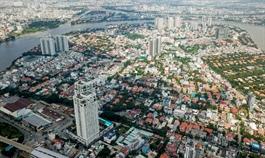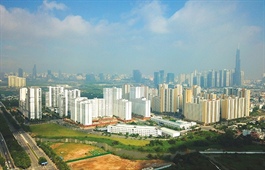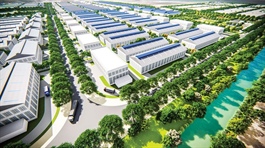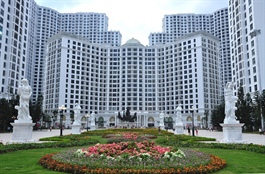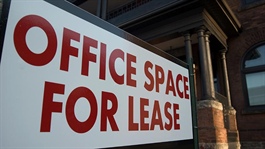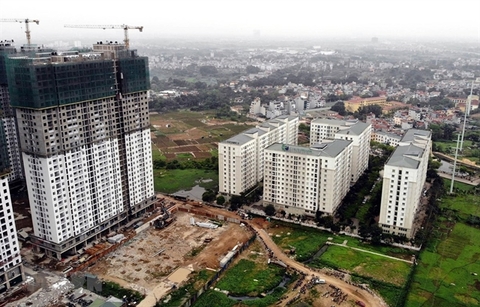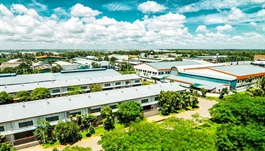Developers’ commitment to Vietnam illustrating strengths
Developers’ commitment to Vietnam illustrating strengths
After a period of strong negative impacts caused by the pandemic, real estate investment activities in Asia-Pacific and Vietnam in particular started to show signs of recovery in the second half of the year, and are expected to return towards a stable increase moving into 2021 and 2022.

This year’s overall activity in the residential real estate sector has been slowed down, yet also saw some considerable M&A deals happening, photo Le Toan
|
According to the latest report released by JLL Vietnam, Asia-Pacific real estate investment showed signs of recovery in the third quarter of 2020 with $35 billion in direct transactions committed between July and September. Transactional activity accelerated across several major markets as investors deployed capital with more confidence than at any other period in the year.
In Vietnam, many domestic developers are raising capital for large-scale development portfolios. These portfolios are attractive to investors because of the size of cash flow, high returns, and growth potential of an emerging real estate market, according to the report.
Although these transactions are still under negotiation and legal review, this is still considered a positive factor for Vietnam’s real estate market because of foreign investors’ confidence in market recovery and improvement of buyers’ purchasing power in the coming quarters.
According to Khanh Nguyen, senior director of Capital Markets at JLL Vietnam, although the international travel ban in the first half of 2020 had some impact on initiating new transactions as foreign investors could not inspect the assets, attempts to resume passenger flights in several Asian countries will help expedite the transaction process.
“We have observed a number of local investors and, most recently, Japanese investors who are looking to tap into this lucrative segment. In addition, the demand for hundreds of hectares of industrial development land to develop industrial parks from other international investors is increasing. However, finding opportunities with suitable zoning and clean and clear legal titles remain challenging, especially in southern provinces such as Dong Nai and Binh Duong,” Nguyen said.
Amid travel restrictions, the industrial property sector’s activity revolves around companies in Vietnam expanding or relocating their production.
Activity despite slowdown
Despite the ongoing pandemic, a number of key mergers and acquisitions (M&A) deals took place in the third quarter of 2020. LOGOS from Australia entered the market with their $350 million logistics development joint venture.
Asia’s largest warehouse developer GLP is planning to cooperate with Vietnam’s SEA Logistic Partners, or SLP, in a $1.5 billion new venture. Furthermore, South Korean firm Mirae Asset Daewoo Company and Naver Corporation jointly invested $37 million in a warehouse in LogisValley hub in the northern province of Bac Ninh.
Regarding manufacturing investments, Apple supplier and electronics giant Pegatron, from Taiwan, invested over $19 million newly-registered capital into the northern port city of Haiphong for the first phase of their Vietnamese expansion plans, as pointed out by John Campbell, manager of Industrial Services at Savills Vietnam
“It’s more important than ever that some of the world’s most renowned logistics developers and manufacturers are committing to Vietnam, demonstrating their belief in the country’s long-term potential despite the difficulties posed by the pandemic,” said Campbell.
With the demand continuing to outpace supply with industrial zones’ (IZs) occupancy reaching 76 per cent nationally, there’s a clear need for more supply in the key industrial provinces. Occupancy rates in key hubs such as Binh Duong, Dong Nai, Long An in the south, and Bac Ninh, Hung Yen, and Haiphong in the north, has risen significantly since 2018.
With an expected influx on manufacturers moving out of China in 2021 and 2022, it may be vital for developers to bring more live projects to catch and accommodate high value manufacturing investments.
For example, Dong Nai plans eight additional IZs, while BW Industrial Development JSC is racing to expand during this time, growing their initial supply from 130 hectares in 2018 to almost 500ha this year.
Investment activity in the residential segment has been slowed down this year; mainly due to the effect of COVID-19, price-policy and other investigations from local authorities to review a range of projects, and general credit quality control in real estate.
However, there have been a number of noticeable M&A transactions involving some of the biggest names in the industry.
For instance, earlier this year Singaporean investment company Temasek Holdings, alongside the US private equity manager KKR, were part of a group of investors that purchased 6 per cent of property developer Vinhomes for VND15.1 trillion ($650 million) from parent company Vingroup.
Vietnam’s real estate M&As have typically involved large-scale projects, newly developing urban areas, resort properties, and luxury hotels in various beach areas across the country.
According to Lim Hua Tiong, CEO of Frasers Property Vietnam, Vietnam has gradually become one of the hottest destinations for M&A activities in Southeast Asia.
“The Vietnamese real estate market will only become more attractive for international developers and funds in the coming years. Moreover, with great efforts from the central government, the current legal system has become more transparent and will continue to be so. This is a key factor which will continue to speed up foreign investment in the economy,” said Tiong.
“While COVID-19 had a temporary dampening effect on M&A activities, especially on cross-border deals, it also enhanced the positive image of Vietnam among investors, thanks to the government’s quick actions to control the pandemic,” Tiong added. “Moreover, fast urbanisation has resulted in the positive growth of the real estate and building materials market and raises the housing demand that is unmet by a shortage of affordable housing supply.”
Market resumption
Experts reaffirmed that the M&A market in Vietnam will follow good growth in the last months of 2020 and will strongly recover in following years.
Jack Nguyen from Mazars Vietnam noted that international investors on the hunt to invest in Vietnamese real estate are mostly from Japan, South Korea, Indonesia, Singapore, China, and more recently from the Middle East. “Many of these investors look for projects that will generate good cash flows, stable profitability, and long-term appreciation,” Nguyen said.
The biggest reason for foreign investors’ bullishness is the continued demand for condo apartments and housing for the country’s nearly 100 million people. With increased economic growth, fast urbanisation, and a large young population, there is increasing demand for housing, “some have noted that it was difficult to invest in Indonesia, the market in Singapore is too small, and Malaysia and Thailand have started developing many years ahead of Vietnam,” explained Nguyen.
“These investors generally look to partner with Vietnamese developers that have market experience, financial capacity, and approved projects,” he said.
Although there are now many capable local developers, most buyers with financial capability still prefer to buy an overseas brand developer.
Projects that generate interests include quality assets, and those demonstrating rental growth, larger transaction sizes, and longer tenure. Many landowners are also seeking new partners as the government has tightened loans for the real estate sector. Foreign developers and investors are looking for companies with a large land bank, or projects which are not too far from the central city areas to acquire or co-develop.
“Whilst international investors are always welcomed in the Vietnamese market, there has always been the concern too much foreign investment may lessen local developers’ advantages. However, aside from such negative perspectives it is important to consider the advantages that foreign investors can indeed offer,” Nguyen said.
He added that there is significant “dry powder” sitting in real estate funds around the world, more and more of which is being directed towards Southeast Asia and Vietnam in particular.
“With yields around the world at record lows, across multiple asset classes, there are few markets able to offer long-term returns comparable to Vietnam,” Nguyen said. “These returns are underwritten by all the growth fundamentals already highlighted, such as the young demographics, rapid urbanisation, improving infrastructures and the growing middle class.”




